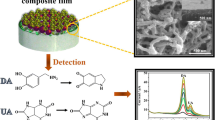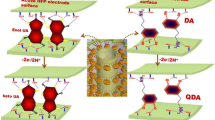Abstract
Heterostructures have potential to blend the advantages of each material, even exhibiting the evolutionary performance due to synergistic effects. Herein, covalent organic polymers (NUF) are integrated with a TiO2/Ti3C2Tx nanocomposite (TiO2/TiCT) to form TiO2/TiCT-NUF heterojunctions as an enlarged nonenzymatic biosensor for dopamine (DA) and uric acid (UA). Detection is performed by differential pulse voltammetry (DPV). The TiO2/TiCT/NUF exhibits high sensing activity with low detection limits of 0.2 and 0.18 nM (S/N = 3) in the concentration ranges from 0.002 to 100 μM and 0.001 to 60 μM for simultaneous determination of DA and UA, respectively. In addition, the TiO2/TiCT/NUF provides good selectivity and reproducibility for DA and UA detection in urine and serum samples with recoveries of 98.4 to 100.9%. The proposed heterojunctions manifest an intriguing potential as a candidate of an electrochemical sensor for sole and simultaneous detection of DA and UA.
Graphical abstract








Similar content being viewed by others
References
Zhang W, Liu L, Li Y, Wang D, Ma H, Ren H, Shi Y, Han Y, Ye BC (2018) Electrochemical sensing platform based on the biomass-derived microporous carbons for simultaneous determination of ascorbic acid, dopamine, and uric acid. Biosens Bioelectron 121:96–103
Lu D, Fan M, Cai R, Huang Z, You R, Huang L, Feng S, Lu Y (2020) Silver nanocube coupling with a nanoporous silver film for dual-molecule recognition based ultrasensitive SERS detection of dopamine. Analyst 145(8):3009–3016
Shahamirifard SA, Ghaedi M, Razmi Z, Hajati S (2018) A simple ultrasensitive electrochemical sensor for simultaneous determination of gallic acid and uric acid in human urine and fruit juices based on zirconia-choline chloride-gold nanoparticles-modified carbon paste electrode. Biosens Bioelectron 114:30–36
Li N, Nan C, Mei X, Sun Y, Feng H, Li Y (2020) Electrochemical sensor based on dual-template molecularly imprinted polymer and nanoporous gold leaf modified electrode for simultaneous determination of dopamine and uric acid. Mikrochim Acta 187(9):496
Zhang X, Chen X, Kai S, Wang HY, Yang J, Wu FG, Chen Z (2015) Highly sensitive and selective detection of dopamine using one-pot synthesized highly photoluminescent silicon nanoparticles. Anal Chem 87(6):3360–3365
Liu Y, Li H, Guo B, Wei L, Chen B, Zhang Y (2017) Gold nanoclusters as switch-off fluorescent probe for detection of uric acid based on the inner filter effect of hydrogen peroxide-mediated enlargement of gold nanoparticles. Biosens Bioelectron 91:734–740
Amjadi M, Hallaj T, Nasirloo E (2020) In situ formation of Ag/Au nanorods as a platform to design a non-aggregation colorimetric assay for uric acid detection in biological fluids. Microchem J 154:104642
Yu L, Butler D, Lucking MC, Zhang F, Xia T, Fujisawa K, Nakajima TG, Silva RC, Endo M, Terrones M, Terrones M, Ebrahimi A (2020) Single-atom doping of MoS2 with manganese enables ultrasensitive detection of dopamine: experimental and computational approach. Sci Adv 6:eabc4250
Sajid M, Nazal MK, Mansha M, Alsharaa A, Jillani SMS, Basheer C (2016) Chemically modified electrodes for electrochemical detection of dopamine in the presence of uric acid and ascorbic acid: a review. TrAC Trends Anal Chem 76:15–29
Iranmanesh T, Foroughi MM, Jahani S, Shahidi Zandi M, Hassani Nadiki H (2020) Green and facile microwave solvent-free synthesis of CeO2 nanoparticle-decorated CNTs as a quadruplet electrochemical platform for ultrasensitive and simultaneous detection of ascorbic acid, dopamine, uric acid and acetaminophen. Talanta 207:120318
Li YY, Kang P, Wang SQ, Liu ZG, Li YX, Guo Z (2021) Ag nanoparticles anchored onto porous CuO nanobelts for the ultrasensitive electrochemical detection of dopamine in human serum. Sensors Actuators B Chem 327:128878
Wang M, Hu M, Liu J, Guo C, Peng D, Jia Q, He L, Zhang Z, Du M (2019) Covalent organic framework-based electrochemical aptasensors for the ultrasensitive detection of antibiotics. Biosens Bioelectron 132:8–16
Cao X, Xu H, Dong S, Xu J, Qiao Z, Zhao S, Wang J, Wang Z (2020) Preparation of high-performance and pressure-resistant mixed matrix membranes for CO2/H2 separation by modifying COF surfaces with the groups or segments of the polymer matrix. J Membr Sci 601:117882
Li CC, Gao MY, Sun XJ, Tang HL, Dong H, Zhang FM (2020) Rational combination of covalent-organic framework and nano TiO2 by covalent bonds to realize dramatically enhanced photocatalytic activity. Appl Catal B 266:118586
Cui X, Lei S, Wang AC, Gao L, Zhang Q, Yang Y, Lin Z (2020) Emerging covalent organic frameworks tailored materials for electrocatalysis. Nano Energy 70:104525
Wang J, Yang X, Wei T, Bao J, Zhu Q, Dai Z (2018) Fe-Porphyrin-based covalent organic framework as a novel peroxidase mimic for a one-pot glucose colorimetric assay. ACS Appl Bio Mater 1(2):382–388
Zhang D, Wang Y, Geng W, Liu H (2019) Rapid detection of tryptamine by optosensor with molecularly imprinted polymers based on carbon dots-embedded covalent-organic frameworks. Sensors Actuators B Chem 285:546–552
Zhang X, Li G, Wu D, Zhang B, Hu N, Wang H, Liu J, Wu Y (2019) Recent advances in the construction of functionalized covalent organic frameworks and their applications to sensing. Biosens Bioelectron 145:111699
Sun Y, He J, Waterhouse GIN, Xu L, Zhang H, Qiao X, Xu Z (2019) A selective molecularly imprinted electrochemical sensor with GO@COF signal amplification for the simultaneous determination of sulfadiazine and acetaminophen. Sensors Actuators B Chem 300:126993
Liang C, Lin H, Wang Q, Shi E, Zhou S, Zhang F, Qu F, Zhu G (2020) A redox-active covalent organic framework for the efficient detection and removal of hydrazine. J Hazard Mater 381:120983
Zhao L, Dong B, Li S, Zhou L, Lai L, Wang Z, Zhao S, Han M, Gao K, Lu M, Xie X, Chen B, Liu Z, Wang X, Zhang H, Li H, Liu J, Zhang H, Huang X, Huang W (2017) Interdiffusion reaction-assisted hybridization of two-dimensional metal-organic frameworks and Ti3C2Tx nanosheets for electrocatalytic oxygen evolution. ACS Nano 11(6):5800–5807
Xu Y, Wang S, Yang J, Han B, Nie R, Wang J, Wang J, Jing H (2018) In-situ grown nanocrystal TiO2 on 2D Ti3C2 nanosheets for artificial photosynthesis of chemical fuels. Nano Energy 51:442–450
Li N, Jiang Y, Zhou C, Xiao Y, Meng B, Wang Z, Huang D, Xing C, Peng Z (2019) High-performance humidity sensor based on urchin-like composite of Ti3C2 MXene-derived TiO2 nanowires. ACS Appl Mater Interfaces 11(41):38116–38125
Xue R, Guo H, Yue L, Wang T, Wang M, Li Q, Liu H, Yang W (2018) Preparation and energy storage application of a long-life and high rate performance pseudocapacitive COF material linked with –NH–bonds. New J Chem 42(16):13726–13731
Zhang S, Zhao X, Li B, Bai C, Li Y, Wang L, Wen R, Zhang M, Ma L, Li S (2016) “Stereoscopic” 2D super-microporous phosphazene-based covalent organic framework: design, synthesis and selective sorption towards uranium at high acidic condition. J Hazard Mater 314:95–104
Li Q, Zhong B, Zhang W, Jia Z, Jia D, Qin S, Wang J, Razal JM, Wang X (2019) Ti3C2 MXene as a new nanofiller for robust and conductive elastomer composites. Nanoscale 11(31):14712–14719
Zhang CJ, Pinilla S, McEvoy N, Cullen CP, Anasori B, Long E, Park SH, Seral Ascaso A, Shmeliov A, Krishnan D, Morant C, Liu X, Duesberg GS, Gogotsi Y, Nicolosi V (2017) Oxidation stability of colloidal two-dimensional titanium carbides (MXenes). Chem Mater 29(11):4848–4856
Chen Y, Wang D, Lin Y, Zou X, Xie T (2019) In suit growth of CuSe nanoparticles on MXene (Ti3C2) nanosheets as an efficient counter electrode for quantum dot-sensitized solar cells. Electrochim Acta 316:248–256
Verma S, Arya P, Singh A, Kaswan J, Shukla A, Kushwaha HR, Gupta S, Singh SP (2020) ZnO-rGO nanocomposite based bioelectrode for sensitive and ultrafast detection of dopamine in human serum. Biosens Bioelectron 165:112347
Wang Y, Wu Q, Zhang B, Tian L, Li K, Zhang X (2020) Recent advances in transition metal carbide electrocatalysts for oxygen evolution reaction. Catalysts 10(10):1164
Raj M, Gupta P, Goyal RN, Shim YB (2017) Graphene/conducting polymer nano-composite loaded screen printed carbon sensor for simultaneous determination of dopamine and 5-hydroxytryptamine. Sensors Actuators B Chem 239:993–1002
Huang Q, Zhang H, Hu S, Li F, Weng W, Chen J, Wang Q, He Y, Zhang W, Bao X (2014) A sensitive and reliable dopamine biosensor was developed based on the au@carbon dots-chitosan composite film. Biosens Bioelectron 52:277–280
Liang Z, Zhai H, Chen Z, Wang H, Wang S, Zhou Q, Huang X (2016) A simple, ultrasensitive sensor for gallic acid and uric acid based on gold microclusters/sulfonate functionalized graphene modified glassy carbon electrode. Sensors Actuators B Chem 224:915–925
Yan X, Gu Y, Li C, Tang L, Zheng B, Li Y, Zhang Z, Yang M (2016) Synergetic catalysis based on the proline tailed metalloporphyrin with graphene sheet as efficient mimetic enzyme for ultrasensitive electrochemical detection of dopamine. Biosens Bioelectron 77:1032–1038
Wang S, Ma Y, Wang Y, Jiao M, Luo X, Cui M (2020) One-step electrodeposition of poly(m-aminobenzoic acid) membrane decorated with peptide for antifouling biosensing of Immunoglobulin E. Colloids Surf B: Biointerfaces 186:110706
Funding
This study received financial support from the National Natural Science Foundation of China (Nos. 21771047, 21403048, 21401147 and 21571045), University Nursing Program for Young Scholars with Creative Talents in Heilongjiang Province (No. UNPYSCT-2017183), Harbin Science and Technology Bureau (2016RAQXJ161), and PhD Research Startup Program of Harbin Normal University, China (No. XKB201310).
Author information
Authors and Affiliations
Corresponding authors
Ethics declarations
Competing interests
The authors declare no competing interests.
Conflict of interest
The authors declare that they have no competing of interests.
Additional information
Publisher’s note
Springer Nature remains neutral with regard to jurisdictional claims in published maps and institutional affiliations.
Supplementary Information
ESM 1
(DOCX 2796 kb)
Rights and permissions
About this article
Cite this article
Lu, X., Li, S., Guo, W. et al. A covalent organic polymer–TiO2/Ti3C2 heterostructure as nonenzymatic biosensor for voltammetric detection of dopamine and uric acid. Microchim Acta 188, 95 (2021). https://doi.org/10.1007/s00604-021-04755-8
Received:
Accepted:
Published:
DOI: https://doi.org/10.1007/s00604-021-04755-8




